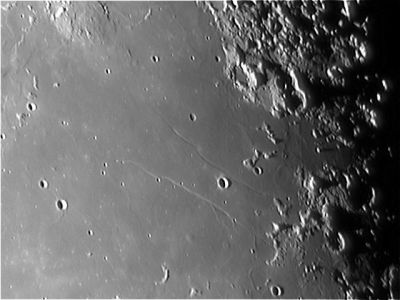Cauchy
Contents
Cauchy
|
Lat: 9.6°N, Long: 38.6°E, Diam: 12 km, Depth: 2.67 km, Rükl: 36 |

Derek Francis Cauchy is the small circular crater at about 4 o'clock from the center of this Earth-based image. The faint diagonal lines nearby are Rima Cauchy (above) and Rupes Cauchy (below).
Images
LPOD Photo Gallery Lunar Orbiter Images Apollo Images
- ASU Apollo Image of the Week
- AS08-13-2344 is perhaps the most well-known and most frequently reproduced orbital Hasselblad of Cauchy and the nearby Rima Cauchy and Rupes Cauchy. This extraordinary photograph was included on pages 616-617 of the article A Most Fantastic Voyage by Lt. Gen. Sam C. Phillips (The Story of Apollo 8's Rendez-Vous with the Moon; National Geographic, May 1969). Research: Danny Caes.
Maps
(LAC zone 61A3) LAC map Geologic map LTO map USGS Digital Atlas (nomenclature PDF)
Description
Description: Elger
(IAU Directions) CAUCHY.--A bright little crater, not more than 7 or 8 miles in diameter, on the E. side of the Mare Tranquillitatis, N.W. of Taruntius. It has a peak on its E. rim considerably loftier than the rest of the wall, which is visible as a brilliant spot at sunrise long before the rest of the rampart is illuminated. On the S. there are two bright longitudinal ridges ranging from N.W. to S.E. These stand in the position where Neison draws two straight clefts. The Cauchy cleft, however, lies N. of these, and terminates, as shown by Schmidt, among the mountains N.W. of Taruntius. I have seen it thus on many occasions, and it is so represented in a drawing by M.W. Stuvaert (Dessins de la Lune). There is a number of minute craters and mounds standing on the S. side of this cleft, and many others in the vicinity.
Description: Wikipedia
Additional Information
- Depth data from Kurt Fisher database
- Pike, 1976: 2.67 km
- Arthur, 1974: 2.61 km
- Westfall, 2000: 2.67 km
- Viscardy, 1985: 2.6 km
- Cherrington, 1969: 1.79 km
- Cauchy & Cauchy D are thermal anomaly craters, implying youthful ages - Moore et al, 1980
- Cauchy shows a curious clair-obscur effect at the shadow of its western rim, a couple of hours after local sunrise. The shadow looks "interrupted" at its central part. This "interruption" is caused by a curious wing-like formation at the crater's western rim. Two wing-like appendages run north-northwest and south-southwest (radiating out of the crater's western rim). A similar formation is noticeable at crater Kies A in the southwestern part of Mare Nubium. Observations and research: Danny Caes.
- Paolo Lazzarotti's LPOD photo of Cauchy and surroundings shows the curious "interrupted" appearance of Cauchy's shadow very well!- DannyCaes Jan 20, 2009
- TSI = 10, CPI = 5, FI = 5; MI =20 Smith and Sanchez, 1973
Nomenclature
- Named for Augustin Louis Cauchy (August 21, 1789 – May 23, 1857), a French mathematician. He started the project of formulating and proving the theorems of calculus in a rigorous manner and was thus an early pioneer of analysis.
- According to Whitaker (p. 223), this name was introduced by Neison.
- On LTO-61B4 (prepared in November 1973) the DMA erroneously introduced the name Noether for the satellite feature Cauchy D. The name Noether (spelled there "Nöther (or Nöter)") had actually been previously approved by the IAU for an unrelated farside crater, and had been published in Menzel, 1971. Hence the use of Noether as a replacement for Cauchy D appears in Ewen Whitaker's list of Invalid Names.
- Cauchy A is called Hussein on LTO-61A2. This is another invalid name. Who was Hussein? See this Wikipedia-page.
- Hussein (Cauchy A) is one of the few LTO-related "new" crater-names which are located at the moon's Near Side. Most of those names are located at the moon's eastern limb (near Mare Smythii), and at the moon's Far Side. - DannyCaes Mar 29, 2008
- Cauchy D hills (a nickname from D.Caes for the cluster of hills north-northeast of the bowl-shaped crater Cauchy D, at the western part of Sinus Concordiae) (these hills seem to be sections of an ancient crater, see SLC-A4) (System of Lunar Craters).
LPOD Articles
Is it love or a sinus infection?
Cauchy times two
Lunar 100
L48: "Fault, rilles, & domes."
Bibliography
Wöhler, C. and others (2006) A combined spectrophotometric and morphometric study of the lunar mare dome fields near Cauchy, Arago, Hortensius and Milichius. Icarus.